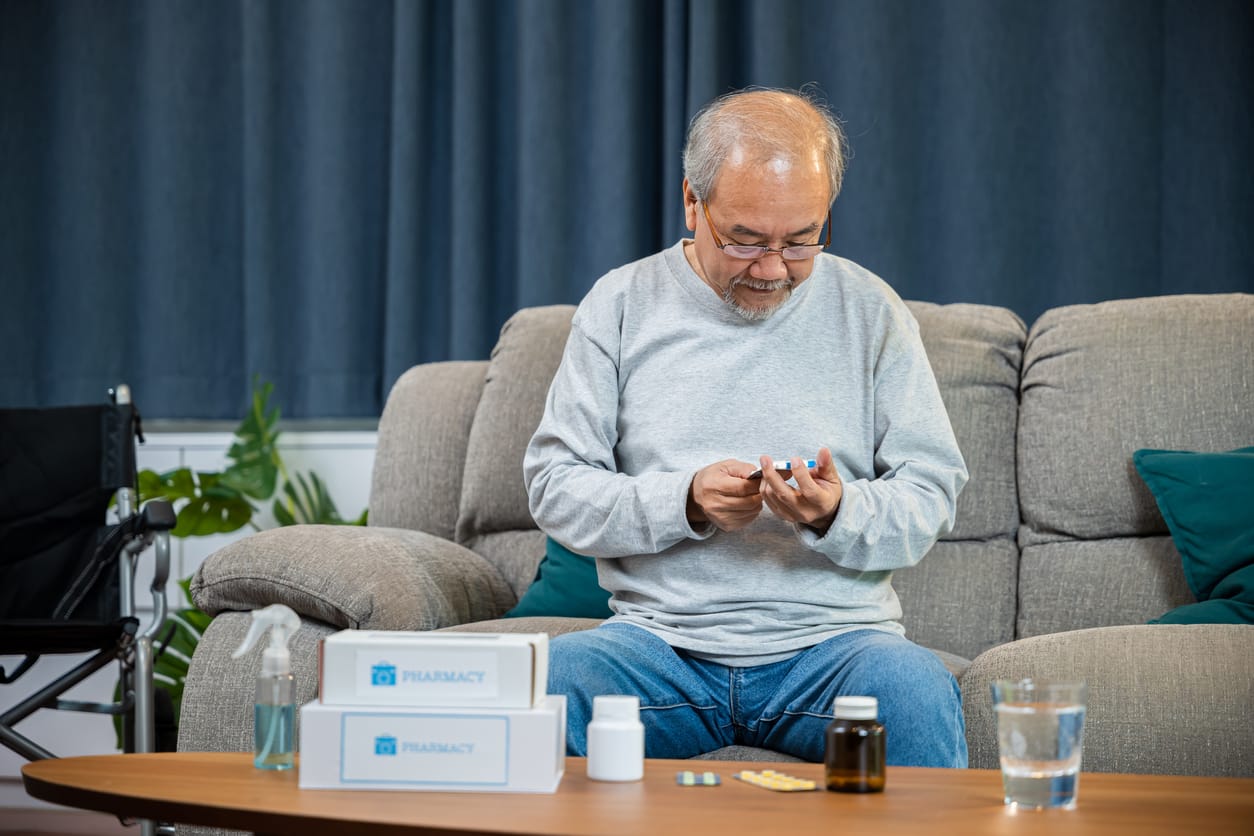Diabetes is a chronic medical condition that affects millions of people worldwide. It is characterized by the body's inability to regulate blood sugar levels properly, leading to elevated glucose levels in the bloodstream.
The prevalence of diabetes increases with age, making seniors a particularly vulnerable population. According to the World Health Organization (WHO), diabetes is one of the leading causes of death among seniors globally.
The aging process, with its metabolic shifts, increased insulin resistance, and susceptibility to chronic ailments, conspires to elevate the incidence of diabetes in seniors. Consequently, a comprehensive approach to diabetes management becomes imperative in safeguarding their health and well-being.
In the quest for diabetes management, we'll uncover the vital threads that work together to balance blood sugar and reduce complications for seniors.
Diabetes Management: What Does It Involve?
Diabetes management is a multifaceted approach aimed at controlling and mitigating the impact of diabetes on an individual's health and well-being. This comprehensive process involves various elements that work together to maintain stable blood sugar levels and reduce the risk of complications. Essential components of diabetes management:
Nutritional Management for Seniors with Diabetes
Diet plays a central role in managing diabetes, as it directly impacts blood sugar levels. Seniors with diabetes should aim for a diet that controls carbohydrates to prevent sharp spikes and dips in blood sugar levels. Focus should be on complex carbohydrates, such as whole grains, legumes, and vegetables, which are digested more slowly and have a gentler effect on blood sugar.
Complex Carbohydrates: These carbohydrates are slower to digest and have a gentler impact on blood sugar levels. Encourage seniors to include foods like:
- Whole grains: Whole wheat, brown rice, quinoa, and oats.
- Legumes: Lentils, chickpeas, black beans, and kidney beans.
- Vegetables: Non-starchy options like leafy greens, broccoli, cauliflower, and bell peppers.
Reducing Meat Consumption: While lean sources of protein like poultry and fish are beneficial, it's also important to reduce red and processed meat consumption.
The study titled "Red meat intake and risk of type 2 diabetes in a prospective cohort study of US females and males" led by Xiao Gu and published in The American Journal of Clinical Nutrition on October 19, 2023 revealed a robust connection between the intake of red meat, both processed and unprocessed, and a significantly elevated risk of developing type 2 diabetes. Individuals with the highest consumption of red meat faced a 62% increased risk of developing type 2 diabetes in comparison to those with the lowest intake. Furthermore, each additional daily serving of processed red meat was linked to a 46% higher risk of developing type 2 diabetes, while unprocessed red meat consumption was associated with a 24% higher risk for each additional daily serving.
The researchers also conducted an analysis to determine the potential outcomes of replacing one daily portion of red meat with an alternative protein source. Their findings indicated that substituting a serving of nuts and legumes was linked to a 30% reduced risk of developing type 2 diabetes, while substituting a serving of dairy products was associated with a 22% lower risk
Suggest plant-based protein sources such as:
- Beans: Black beans, kidney beans, and pinto beans.
- Tofu and tempeh.
- Nuts and seeds: Almonds, walnuts, chia seeds, and flaxseeds.
"Replacing red meat with healthy plant-based protein sources, such as nuts and legumes, or modest amounts of dairy foods, was associated with reduced risk of type 2 diabetes. Given our findings and previous work by others, a limit of about one serving per week of red meat would be reasonable for people wishing to optimize their health and wellbeing." - Walter Willett, Professor of Epidemiology and Nutrition, Harvard T.H. Chan School of Public Health
Healthy Fats: Include sources of healthy fats in their diet to support heart health and meal satisfaction, such as:
- Avocados: Great for adding creaminess to dishes.
- Nuts and seeds: Rich in heart-healthy fats.
- Olive oil: Use for cooking and dressing salads.
- Fatty fish: Salmon, mackerel, and sardines are rich in omega-3 fatty acids.
Portion Control: Seniors should be mindful of portion sizes to prevent overeating. Teach them to use measuring cups and visual cues to estimate portion sizes, as this can be particularly important for carbohydrate-containing foods.
Snacking: Nutrient-dense snacks can help seniors manage cravings without affecting blood sugar levels significantly. Suggest snacks like:
- Raw vegetables with hummus.
- Greek yogurt (choose low-fat or non-fat options).
- A handful of unsalted nuts.
Hydration: Staying hydrated is important for overall health. Encourage seniors to drink water throughout the day. Herbal teas and water with a squeeze of lemon or cucumber can add flavor without added sugars.
Sweet Alternatives: Using natural sweeteners like stevia, monk fruit, or small amounts of honey can satisfy sweet cravings without causing rapid blood sugar spikes.
Diabetes-friendly recipes for seniors:
Quinoa and Black Bean Salad:
In a large bowl, combine 1 cup of cooked quinoa, a can (15 oz) of black beans (drained and rinsed), 1 cup of diced bell peppers (red, green, or yellow), 1 cup of cherry tomatoes (halved), and 1/4 cup of chopped fresh cilantro. In a separate small bowl, whisk together 2 tablespoons of olive oil, 2 tablespoons of fresh lime juice, and salt and pepper to taste. Pour the dressing over the salad and toss to combine. Serve chilled as a side dish or add grilled chicken or tofu for a complete meal.
Baked Salmon with Lemon and Herbs:
Preheat the oven to 375°F (190°C) and place 4 salmon filets on a baking sheet lined with parchment paper. In a small bowl, mix together 2 tablespoons of olive oil, 2 cloves of minced garlic, the zest and juice of 1 lemon, 2 tablespoons of fresh chopped herbs (such as dill, parsley, or basil), and salt and pepper to taste. Drizzle the mixture over the salmon filets and season with salt and pepper. Bake in the preheated oven for 15-20 minutes or until the salmon flakes easily with a fork.
Physical Activity and Diabetes Management
Physical activity is a crucial component of diabetes management for seniors, and loved ones can encourage and support them in staying active. Regular exercise offers several benefits, such as improving insulin sensitivity, aiding in weight management, enhancing cardiovascular health, and contributing to overall well-being. Here are some suggestions for safe and senior-friendly exercises:
- Walking: Walking is a low-impact exercise that can be easily incorporated into daily routines. Seniors can begin with short walks and gradually increase the duration as they become more comfortable.
- Swimming: Swimming is a gentle exercise that's easy on the joints and provides a full-body workout. It's an excellent option for seniors looking for a low-impact exercise routine.
- Tai Chi: Tai Chi is a mind-body practice that focuses on improving balance, flexibility, and reducing stress. It's an effective way for seniors to stay active while enhancing their overall well-being.
Tips for Integrating More Movement into Daily Life:
- Use the Stairs: Encourage seniors to choose stairs over elevators whenever possible. Climbing stairs is a simple way to incorporate more physical activity into daily routines.
- Gardening: Gardening involves a range of movements and can be a therapeutic and enjoyable way for seniors to stay active. It's a great way to engage with nature and promote physical health.
- Stretching Breaks: Suggest incorporating short stretching breaks throughout the day to help maintain flexibility. These breaks can be simple, gentle stretches that can be done while seated or standing, making them accessible and convenient.
Medication Management and Regular Health Check-Ups
For seniors facing the challenges of diabetes, ensuring strict medication adherence is a matter of utmost importance. The medications prescribed by healthcare professionals play a pivotal role in maintaining stable blood sugar levels and averting potential complications. Failure to adhere to these medication regimens can result in fluctuating blood sugar levels, which may have serious consequences. Therefore, it is essential for seniors to follow their healthcare provider's instructions meticulously and remain open about any challenges or concerns they may encounter.
Suggestions for Simplifying Medication Routines for Seniors
- Medication Organizer: To streamline the process and reduce the risk of missed doses, seniors can make use of a pill organizer. This invaluable tool assists in keeping track of their medications and ensures that they take the prescribed doses at the designated times.
- Set Alarms: Seniors can set alarms or reminders on their watch, phone, or clock to prompt them to take their medications as per the prescribed schedule. These reminders can significantly enhance medication adherence and provide a reliable memory aid.
- Sync with Meals: Aligning medication times with meals is an effective strategy for seniors to remember to take their medications regularly. This association with daily routines can be a helpful memory cue.
Role of Regular Check-ups and Blood Sugar Monitoring in Managing Diabetes
Regular health check-ups and consistent blood sugar monitoring are invaluable components of effective diabetes management for seniors. Seniors should establish close collaboration with their healthcare providers to create a schedule for these essential activities.
Regular check-ups empower healthcare professionals to evaluate their overall health, make any necessary adjustments to their medications, and detect any potential complications in their early stages. Simultaneously, blood sugar monitoring yields precious insights into how well blood sugar levels are being managed on a daily basis. This enables seniors to make the vital adjustments needed for their treatment plan.
Revamping Comprehensive Diabetes Management for Seniors
Diabetes poses a significant risk for seniors due to its prevalence and potential complications. Effective management involves a balanced diet, regular exercise, medication adherence, and health check-ups.
A diabetes-friendly diet prioritizes complex carbohydrates, plant-based proteins, and healthy fats while reducing red meat intake. Exercise, such as walking or swimming, improves overall health. Simplifying medication routines with organizers and alarms is crucial, and regular check-ups help in early complication detection. Collaborating with healthcare providers and support networks is essential for successful diabetes management, reducing complications, and enhancing the quality of life for seniors.





